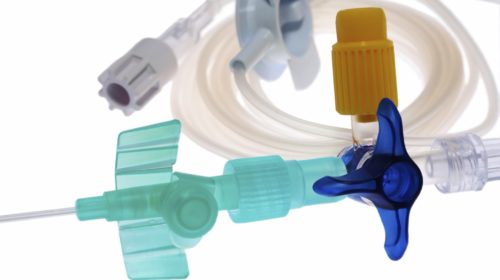
Contractor safely removes asphalt from construction vehicles without water or chemicals
THE SITUATION
The largest road paving and heavy construction company in Ontario specializes in asphalt paving on highways and local roads throughout the province. They are often granted major projects and the company remains busy throughout most of the year. With their machines in constant use, the company is not able to clean them until the offseason when work begins to slow. The machines accumulate layers of asphalt on various parts of the machine, which can be difficult to remove and clean, particularly in hard to reach areas.
One of the main machines the company utilizes is a material transfer vehicle (MTV). These vehicles are designed to deliver the hot mix asphalt from a dump truck to a paver machine. They ensure that the paver is continuously operating and that asphalt is laid down at the ideal temperature. MTVs are constantly transferring hot asphalt and get very dirty, which can cause the machines to lose efficiency.
THE PROBLEM
The MTV has a large frontal hopper where the hot asphalt mix is loaded from the dump truck. The asphalt mix is then transferred to a storage bin via a conveyor. Within the hopper is an auger and two large chains that are part of the conveyor system. The auger and chains accumulate heavy layers of asphalt.
The paving company previously cleaned the parts manually with chisels, water and chemicals. The hopper, auger and chains are difficult to access and the workers had to get in the hopper and chisel at the parts. It would take four workers ten hours to clean these parts. This process was timely and inefficient.
“The paving company wanted to decrease the amount of time it took to clean the vehicle,” said Wes Donaldson of Go Green Dry Ice Blasting, a local contractor the paving company contacted to clean the MTV. “With four guys in the hopper cleaning it, they were using a lot of man hours.”
With the workers chiseling the parts, there is also an added risk that they could damage the expensive parts.
“It’s steel on steel chiseling so there’s a chance that they might damage one of the links,” said Donaldson. “And with the chemicals and heating it up, there’s more risk of damage.”
The company recycles the asphalt that is chipped off the machine. Once the cleaning process is complete, they collect the leftover asphalt and dump it back into the mixer. When the workers use chemicals or water to clean the machine, the asphalt becomes contaminated and it cannot be reused.
The paving company tried other alternative cleaning methods in an attempt to make the process more efficient, but did not find success. The company tried sandblasting, but the sand grit got into all of the chain links and into the rollers. The sand also contaminated the leftover asphalt and was an added expense to cleanup.
THE SOLUTION
The company heard of dry ice blasting as a possible solution and contacted Go Green Dry Ice Blasting to perform a demonstration.
Cold Jet’s dry ice cleaning system uses non-abrasive media in the form of recycled CO2 pellets that won’t damage surfaces or equipment. The combination of dry ice cleaning’s kinetic energy and thermal effects break the connection between the dirt and surface, lifting away contaminants. Unlike blasting with other media, dry ice cleaning does not leave any secondary waste, because the dry ice particles sublimate upon impact – converting from solid to gas. Dry ice cleaning is safe and non-toxic, does not create downstream contamination and reduces or eliminates employee exposure to dangerous chemical cleaning agents.
Dry Ice blasting cools the asphalt on contact, making it easier to remove, leaving the original substrate undamaged.
THE RESULTS
Using Cold Jet’s Aero 40FP with a high flow MERN nozzle, Go Green successfully removed all the asphalt buildup on the hopper, auger and chains. Dry ice blasting worked on all different levels of thickness and buildup.
“We were able to break down the asphalt totally,” said Donaldson. “It didn’t matter how thick it was or where it was, we could break it down and take it off with the dry ice blasting. And we didn’t go overly excessive with the aggression or the air pressure.”
Go Green was able to clean 12 square feet in less than one minute by blasting at 150 PSI with a 400 CFM compressor at five pounds a minute. They used approximately 400 pounds of dry ice for the project.
Dry ice blasting completed the job in half the time that it took the company in the past. Go Green cleaned the MTV in four hours with a one man team compared to the previous method which took ten hours and a four man team. The paving company also liked the fact that dry ice blasting is non-abrasive and will not damage the expensive parts of the machinery.
“When you come in with something non-abrasive, they absolutely love it because they know that when you’re blasting a tough piece of debris that you’re not damaging their equipment, one of the links or a weld,” said Donaldson.
Dry ice blasting does not leave any secondary waste. When the job was complete, only the discarded asphalt remained. This eliminated any secondary cleanup and the leftover asphalt was not contaminated.
“They were really ecstatic about what dry ice blasting did,” said Donaldson. “They were really happy with the chains and augers because those are the hardest parts to clean and take a lot of man hours to clean up because the asphalt is so thick on those parts.”
Donaldson recommends dry ice blasting for cleaning asphalt off any machinery.
“Dry ice blasting is definitely the best option for cleaning asphalt off of equipment,” said Donaldson. “It’s faster, more efficient and is a safer alternative. It’s also non-abrasive and there’s no water or harsh chemicals mixing in with their asphalt.”

